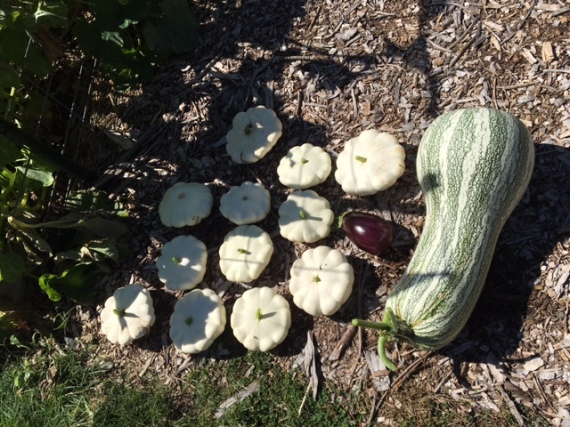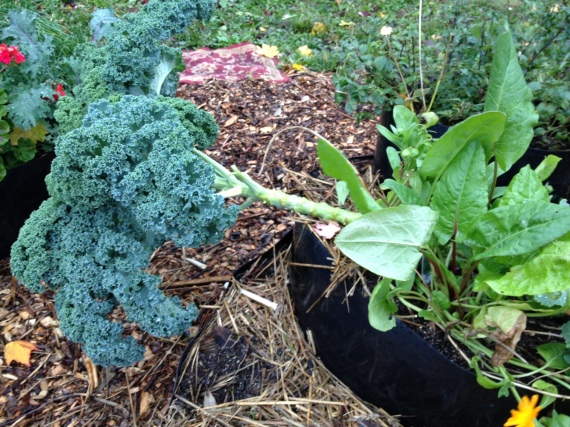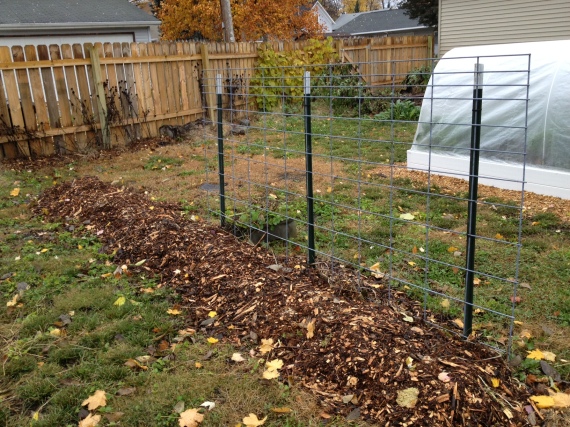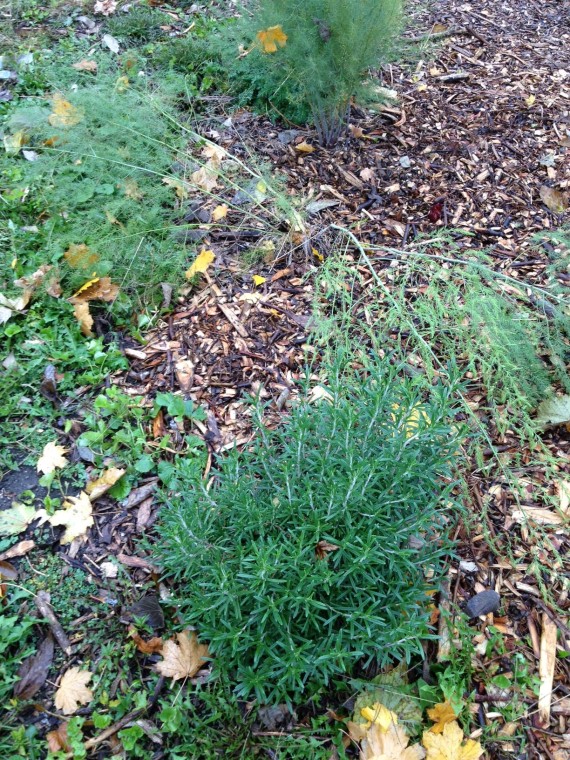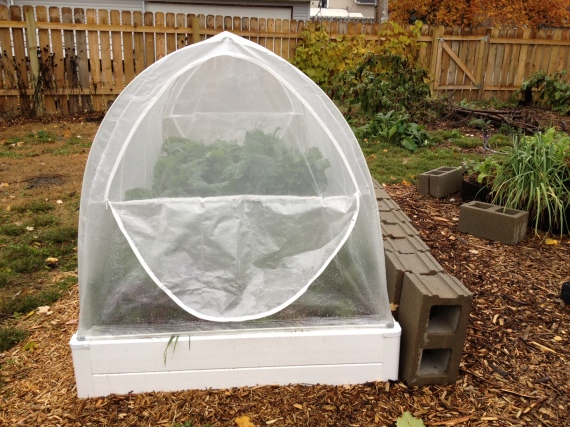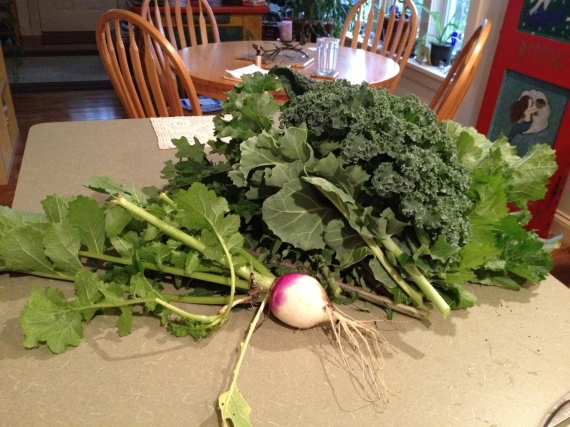It’s that time again! Most people think of Autumn as the time that gardening goes to sleep, but did you know that Fall offers a fantastic time to let Nature do (some of) next year’s garden prep for you? If this year’s fresh produce has ever had you vowing to start a garden next Spring, only to feel the enthusiasm wane when next year rolls around, now is a perfect time to lasagna garden — also known as sheet mulch. Instead of hauling away your leaves now, and then constructing a raised bed and buying expensive soil to fill it in a rush next Spring, you can use Fall’s bounty of leaves and yard waste to begin preparing and fertilizing next year’s garden.
It’s actually very easy! Just lay down a several layers of newspaper or one layer of thick cardboard over whatever area of lawn you’d like to turn into garden. If you’re using newspaper, pick a non-windy day, or make sure you have something to weight down the papers. Otherwise, you’ll just make a mess. 🙂 On top of the newspaper/cardboard, start layering up natural waste: leaves, straw, unfinished compost (i.e., whatever fresh kitchen scraps or compost that hasn’t had time to rot down yet). Mix that up with some peat moss and some kind of minerals (rock dust, vermiculite, etc.), or just keep layering organic matter. Then top it off with some kind of untreated mulch. Surprise, surprise, I’m using wood mulch, as inspired by the film, Back to Eden:

Believe it or not, that’s my fifth(!) pile of wood mulch since April, and I’ve already moved half of it before taking this photo. I’ve been so happy with the wood mulch’s ability to retain water and keep weeds at bay. I’ve only watered our front herb and flower garden twice this year:

When you layer several inches or more of wood mulch on top of a lasagna garden, then everything rots down over the winter, enriching the soil. When I recently divided some of the creeping thyme out front, I found five earthworms within about four square inches of surface soil. Every time I move anything around in this wood mulched area, I find earthworms, a true sign of healthy soil, and I didn’t even lasagna garden the herb bed! I just put a layer of mulch on top of our landlord’s layer of mulch from last year. Nature did the rest. Since herbs prefer poor soil, I didn’t want to waste my time making it too rich with amendments. If you want to grow a decorative and culinary herb garden, laying down some wood mulch this Fall will get your plot ready for next Spring’s seeds or transplants.
I share many of my crazy gardening projects on this blog, because people keep telling me they enjoy the Mad Scientist Gardening experiments, but I do want to note that you can have a fantastic garden without the level of work I’ve put into our yard. We just moved into a place with a tremendously ugly, damaged, weedy, sad, neglected yard — a yard we eagerly accepted because our landlord gave us permission to do whatever we wanted with it. For me, this yard has represented a blank canvas to turn something completely overgrown and forgotten into something gorgeous and functional. It’s a creative outlet much like painting the discarded doors into potent portals. I “paint” with flowers and use plants as form, with food as the function and intention. But anyone can garden in any setting, whether on a small patio in containers, a sunny backyard plot, or turning your front yard into edible landscaping. Lasagna gardening or sheet mulching just represents one more way of enriching the soil to ensure success.

This latest batch of mulch has gone towards lasagna gardening/mulching out a huge swath of front yard, turning it into four beds with a circular path and three side paths for easy plant access. I love the energy going around the circle with my cart full of mulch! It’s quite fun and a big contrast to the straight lines and rougher look of the rest of our street. This last load included two different types of trees, so I decided to use the lighter, harder wood for the paths, and then the darker, softer wood for the top lasagna layers. I’ve planted mums at the edges of each path so that I remember the boundaries next Spring in the event that everything sinks down over the Winter.
I’ve had so much fun rereading “Edible Front Yard” now that I know something about gardening! I first read that book from the Madison Public Library back when I didn’t know anything about planting zones, soil building or microclimates. It makes sooo much more sense now, and I actually recognize many of the edible ornamentals she mentions. It’s fun to imagine how different shapes, heights and colors will combine in each of the four beds in order to create a burst of beauty that also just happens to be edible.
I didn’t get my intended roses and fruit trees planted this Fall; that will need to happen next Spring, as I’ve run out of time for the tasks I’ve already begun. I still have five raspberry bushes/canes to plant out back. Poor things, they’ve sat in pots for two seasons! Speaking of seasons, I’ve also enjoyed figuring out how to bring hints of color and beauty to the yard year round. I found Goshen quite grim last Winter, especially our street, so this year I’ve prioritized delighting my senses even in the middle of December, January and February.
Again, you can have a fabulous garden without needing to figure out all these angles. Moving into this refurbished cottage with the blank slate lawn in a forgotten corridor of Goshen was quite the artistic challenge. I’ve chosen to explode creativity all over the yard, because we’ve had nothing to lose. A more normal setup might just require a bit of creativity to keep a small front yard plot looking good enough for an HOA. I, on the other hand, am in process of shifting a mixed industrial neighborhood plot (formerly the most neglected in the entire neighborhood) into a magical faery paradise. It’s happening, and it’s what I feel called to do … but I don’t want to intimidate people with the level of work I’ve expended. Any efforts to grow even some of your own food and to beautify the world even just a tiny bit have positive ripple effects in your life and in the world. I just enjoy a challenge. 🙂

Thus, we have another Fall/Winter “Guarden” crop coming in, which will soon be covered by a cold frame. Planting these babies in early August resulted in lots of greens and root crops coming in now.

I finally cleared out the cherry tomato plant from the InstaBed, a plant that had spread to three beds and my asparagus! I forgot we even had a gnome beneath all that fruit and foliage.
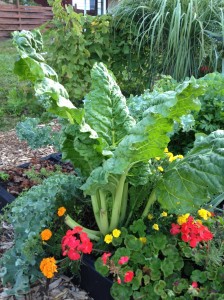
We’ve also got some HUGE chard these days. Massive leaves.

You can see I still have a few “starts” to transplant. It might be too late, but no sign of frost quite yet.

Our Amish paste tomatoes continue to grow and have, more importantly, confirmed to me the suspicion that our ground soil is low in calcium. I had heard that a) lots of dandelion flowers means low calcium soil and b) that tomato plants are excellent indicators of soil health. I did not water these with milk as often as others, because I just wanted to see what happened. Sure enough, the dreaded blossom end rot has struck some of the bigger tomatoes just before they ripen. Blossom end rot is a sign of calcium deficient soil. I’ll add lime and other amendments as I prepare various in ground/trellis beds for next year. Thank you, Nature, for confirming without a soil test. 🙂 I also know that my special, secret soil treatment for organic farms will pay big dividends, since that formula’s loaded with calcium. Yay!

As I walked back around the yard, I caught a glimpse of the front lasagna garden from behind. Just like flower arranging in a vase, I enjoy flower and plant arranging outside in ways that please from all angles. The center bed will change dramatically this weekend as I add a mix of compost and mulch to the flowers. Instead of sunflowers there next year, I plan to have decorative alliums — very Seussian — and zinnias for butterflies, with “Evening Sun” sunflowers on the North side and this year’s Lemon Queen out back. A foretaste of next year’s edible front yard:

Evening Sun image from the seed packet


purple kohlrabi from Seed Savers Exchange

scarlet runner beans


amaranth
And, probably out back:

Mandan Bride Corn

Fairy Tale Pumpkins
On the front trellis (with the star pictured above):

vining, non-bolting Malabar Spinach
Can’t wait for these, some golden fennel and the rest of my medicinal herbs, too. If all goes well, I will have enriched the soil enough and mulched enough to have a relatively low-maintenance and low-water feast for the eyes, nose, mouth and belly.
Happy Gardening!




